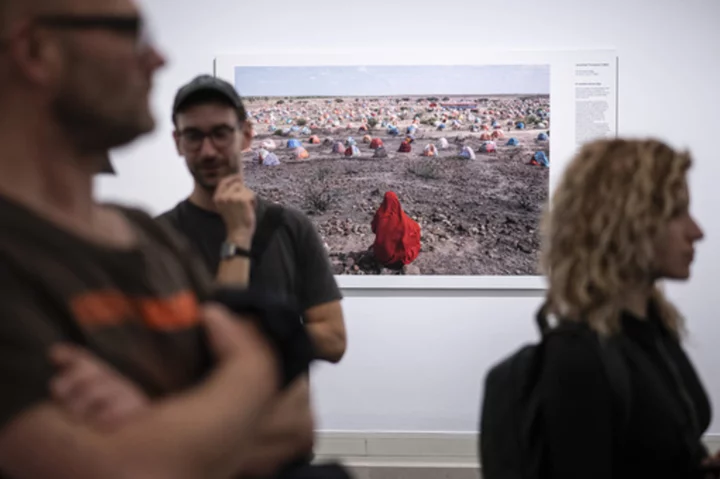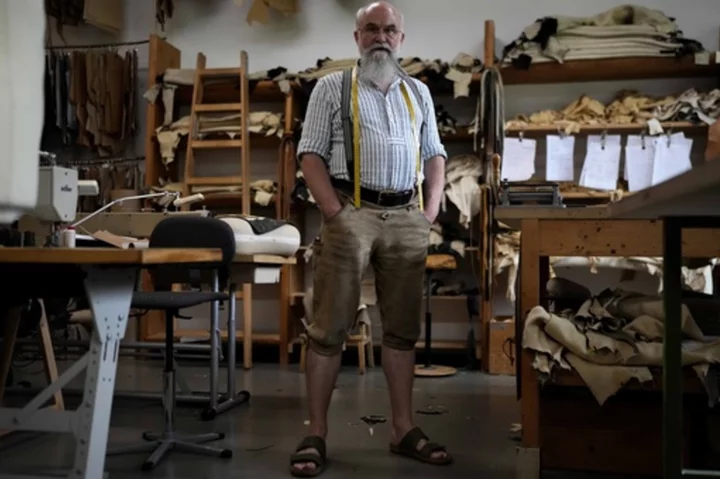BUDAPEST, Hungary (AP) — People younger than 18 have been barred from visiting this year's World Press Photo exhibition in Budapest, after Hungary's right-wing populist government determined that some of its photos violate a contentious law restricting LGBTQ+ content.
The prestigious global photo exhibition, on display in Hungary's National Museum in Budapest, receives more than 4 million visitors from around the world every year. Showcasing outstanding photojournalism, its mission is to bring visual coverage of a range of important events to a global audience.
But a set of five photos by Filipino photojournalist Hannah Reyes Morales led a far-right Hungarian lawmaker to file a complaint with the country’s cultural ministry, which found that they violate a Hungarian law that prohibits the display of LGBTQ+ content to minors.
Now, even with parental consent, those under 18 are no longer allowed to visit the exhibition.
The photographs, which document a community of elderly LGBTQ+ people in the Philippines who have shared a home for decades and cared for each other as they age, depict some community members dressed in drag and wearing make up.
Joumana El Zein Khoury, executive director of World Press Photo, called it worrisome that a photo series “that is so positive, so inclusive,” had been targeted by Hungary’s government. It was the first time that one of the exhibitions had faced censorship in Europe, she said.
“The fact that there is limited access for a certain type of audience is really something that shocked us terribly," Khoury told The Associated Press. “It’s mind-boggling that it’s this specific image, this specific story, and it’s mind-boggling that it’s happening in Europe.”
The move to bar young people from the exhibition was the latest by Hungary's government, led by nationalist Prime Minister Viktor Orbán, to restrict the availability of materials that promote — or depict — homosexuality to minors in media, including television, films, advertisements and literature.
While the government insists that the 2021 “child protection” law is designed to insulate children from what it calls sexual propaganda, it has prompted legal action from 15 countries in the European Union, with the bloc's Commission President Ursula von der Leyen calling it “a disgrace.”
Dora Duro, the far-right lawmaker who filed the complaint over the photos, said she was outraged when she visited the exhibition, and rejected claims that the government's decision limited freedom of the press or free expression.
“How the LGBTQ minority lives is not the biggest problem in the world,” Duro told the AP. “What we see as normal, what we depict and what we convey to (children) as valuable influences them, and this exhibition is clearly harmful to minors and, I think, to adults too.”
Reyes Morales, the photographer, said in an emailed statement that the subjects in her photographs serve as “icons and role models” to the LGBTQ+ community in the Philippines, and that they are “not dangerous or harmful.”
“What is harmful is limiting visibility for the LGBTQIA+ community, and their right to exist and to be seen,” Reyes Morales wrote. “I am beyond saddened that their story might not reach people who need it most, saddened that their story is being kept in a shadow.”
Hungary's cultural ministry did not respond to an interview request.
Tamas Revesz, a former World Press Photo jury member who has been the organizer of Hungary's exhibitions for over three decades, said many of the photographs in the exhibition — such as coverage of the war in Ukraine — are “a thousand times more serious and shocking" than Morales' series.
But given that around half of the some 50,000 people who visit the exhibition in Hungary each year are students, he said, thousands of Hungarian youth will now be unable to view the World Press Photo collection — even those images that are free of LGBTQ+ content.
“The goal of each image and each image report is to bring the news to us, the viewer, and a lot of reporters risk their lives for us to have that knowledge,” Revesz said. "Everyone is free to think what they want about the images on display. These pictures were taken without prejudice, and we too should take what we see here without prejudice.”









